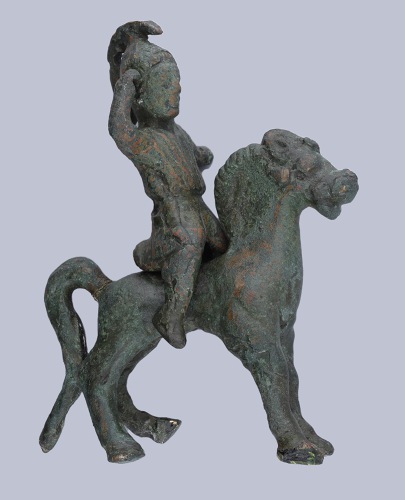Lot Archive



The Lissington Horse and Rider
Roman, Romano-British, Bronze horse and rider figurine, 2nd-3rd century, horse 10cm long by 9cm high by 2.5cm wide, rider 9.5cm high by 4cm wide by 2.5cm deep; the rider wears a belted tunic with vertical folds and a kilt below; he has a crested helmet on his head, his right arm extends sideways and turns up at the elbow with a notch to hold a spear; the left arm extends sideways to the elbow, where a shield would have been attached; the horse has muscular legs, which are straight at the front, while the back legs are bent and there is a long thick curving tail, a thick crested mane, and the eyes are disc-shaped and bulbous; there is a bridle, nose and head band. All the detailing is clear with a slightly uneven green patina and red highlights; the tail has been re-attached £4,000-£5,000
Found at Lissington in Lincolnshire, 2006
The origins of equestrian statues can be traced back to Graeco-Roman examples from Thrace and Danubia in the 3rd century BC. The horse in the Celtic domain received high status and the Celts were accomplished riders, highly regarded by the Roman cavalry. In Roman art the earliest portrayal of horsemen is of the Dioscuri twins Castor and Pollux on Republican coins around 211 BC. Emperors were also frequently depicted on horseback for public monuments. In Roman culture the rite and sacrifice of the October Horse was to ensure a future harvest, and this combined with the god Mars military power providing protection against enemies reveals the importance of the armed horseman. Celtic gods were also identified with Mars wearing his armour but also sometimes portrayed naked.
In Eastern Britain there was a “Cult of the Horseman” with a significant number of finds of bronze figures and enamelled plate brooches being discovered, especially around the Sleaford area. The horseman held high status in Britain with a connection to the Roman god Mars and also to hunting.
Share This Page